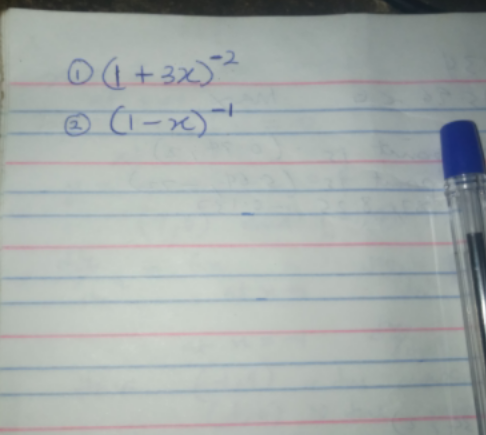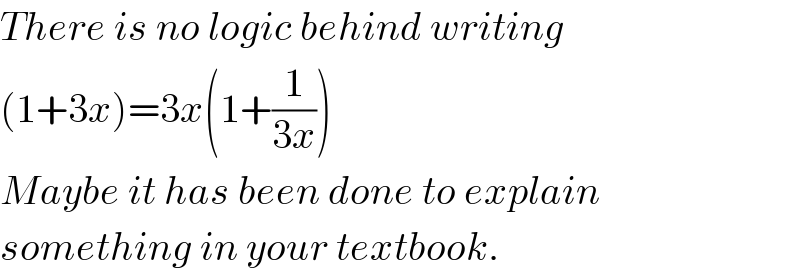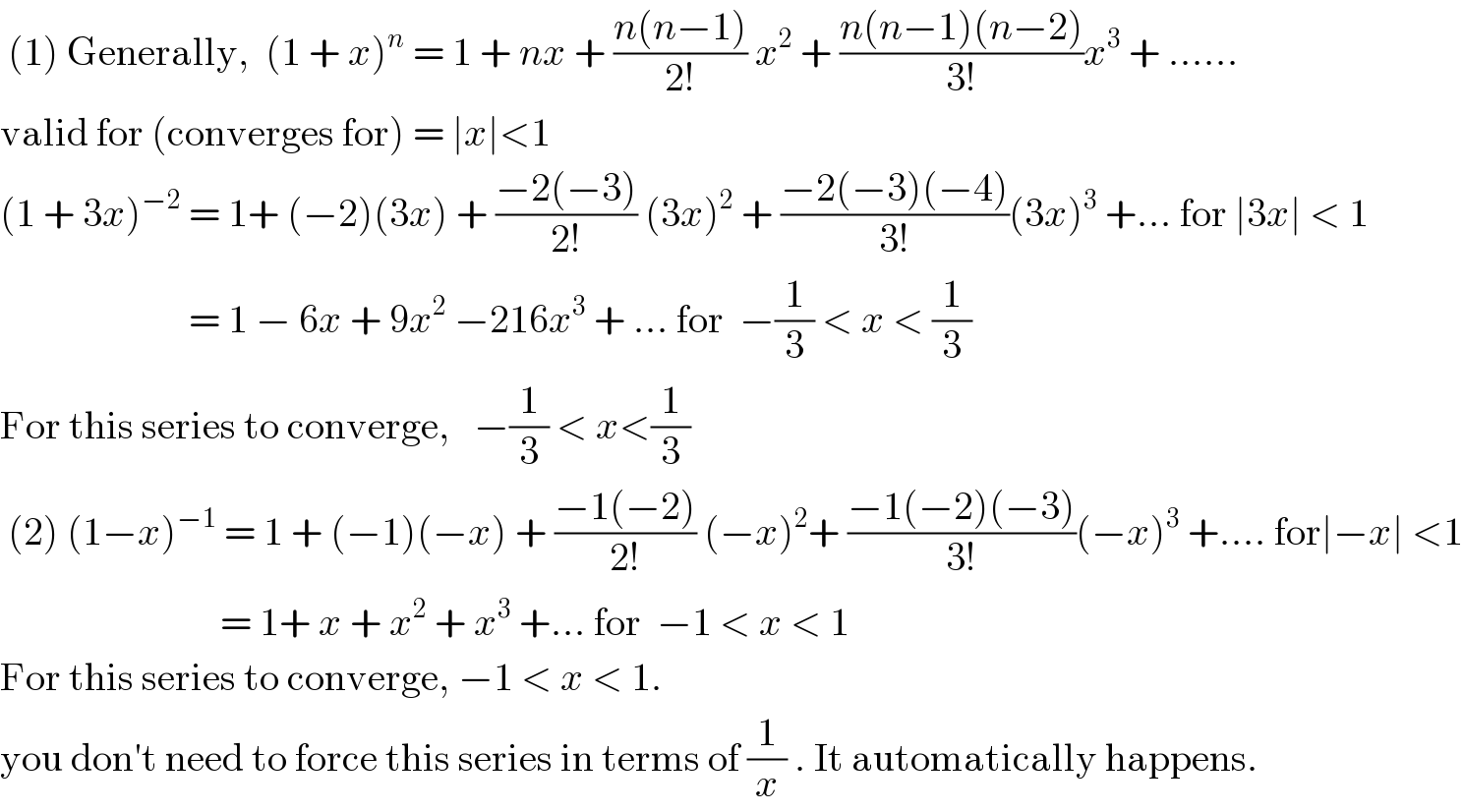Question Number 110109 by aurpeyz last updated on 27/Aug/20

Answered by $@y@m last updated on 27/Aug/20

Commented by Rio Michael last updated on 27/Aug/20
![(3x)^(−2) (1 + (1/(3x)))^(−2) = (1/(9x^2 ))( 1 −(2/(3x)) + (1/(3x^2 ))−(4/(27x^3 )) + ...) (your textbook approach) (3x)^(−2) (1 + (1/(3x)))^(−2) = (3x)^(−2) [1+ (−2)((1/(3x))) + ((−2(−3))/(2!))((1/(3x)))^2 + ((−2(−3)(−4))/(3!))((1/(3x)))^3 +...] = (3x)^(−2) [1−(2/(3x)) + (1/(3x^2 )) − (4/(27x^3 )) +...] valid for ∣(1/(3x))∣ < 1 ⇒ ∣3x∣ <1 ⇔ −(1/3) < x < (1/3) same answer, basically thesame answers.No big difference.](https://www.tinkutara.com/question/Q110127.png)
$$\left(\mathrm{3}{x}\right)^{−\mathrm{2}} \left(\mathrm{1}\:+\:\frac{\mathrm{1}}{\mathrm{3}{x}}\right)^{−\mathrm{2}} \:=\:\frac{\mathrm{1}}{\mathrm{9}{x}^{\mathrm{2}} }\left(\:\mathrm{1}\:−\frac{\mathrm{2}}{\mathrm{3}{x}}\:+\:\frac{\mathrm{1}}{\mathrm{3}{x}^{\mathrm{2}} }−\frac{\mathrm{4}}{\mathrm{27}{x}^{\mathrm{3}} }\:+\:…\right)\: \\ $$$$\left(\mathrm{your}\:\mathrm{textbook}\:\mathrm{approach}\right) \\ $$$$\left(\mathrm{3}{x}\right)^{−\mathrm{2}} \left(\mathrm{1}\:+\:\frac{\mathrm{1}}{\mathrm{3}{x}}\right)^{−\mathrm{2}} \:=\:\left(\mathrm{3}{x}\right)^{−\mathrm{2}} \left[\mathrm{1}+\:\left(−\mathrm{2}\right)\left(\frac{\mathrm{1}}{\mathrm{3}{x}}\right)\:+\:\frac{−\mathrm{2}\left(−\mathrm{3}\right)}{\mathrm{2}!}\left(\frac{\mathrm{1}}{\mathrm{3}{x}}\right)^{\mathrm{2}} \:+\:\frac{−\mathrm{2}\left(−\mathrm{3}\right)\left(−\mathrm{4}\right)}{\mathrm{3}!}\left(\frac{\mathrm{1}}{\mathrm{3}{x}}\right)^{\mathrm{3}} +…\right] \\ $$$$\:\:\:\:\:\:\:\:\:\:\:\:\:\:\:\:\:\:\:\:\:\:\:\:\:\:\:\:\:\:\:\:\:\:\:\:\:\:=\:\left(\mathrm{3}{x}\right)^{−\mathrm{2}} \left[\mathrm{1}−\frac{\mathrm{2}}{\mathrm{3}{x}}\:+\:\frac{\mathrm{1}}{\mathrm{3}{x}^{\mathrm{2}} }\:−\:\frac{\mathrm{4}}{\mathrm{27}{x}^{\mathrm{3}} }\:+…\right] \\ $$$$\mathrm{valid}\:\mathrm{for}\:\mid\frac{\mathrm{1}}{\mathrm{3}{x}}\mid\:<\:\mathrm{1}\:\:\Rightarrow\:\:\mid\mathrm{3}{x}\mid\:<\mathrm{1}\:\Leftrightarrow\:−\frac{\mathrm{1}}{\mathrm{3}}\:<\:{x}\:<\:\frac{\mathrm{1}}{\mathrm{3}} \\ $$$$\mathrm{same}\:\mathrm{answer},\:\mathrm{basically}\:\mathrm{thesame}\:\mathrm{answers}.\mathrm{No}\: \\ $$$$\mathrm{big}\:\mathrm{difference}. \\ $$
Commented by aurpeyz last updated on 27/Aug/20

$${youve}\:{not}\:{answered}\:{the}\:{question} \\ $$
Commented by aurpeyz last updated on 27/Aug/20

$${wow}.\:{thank}\:{you}.\:{is}\:{the}\:{first}\:{one}\:{substitution} \\ $$$${of}\:{n}=\mathrm{1}\:{or}\:\mathrm{2}?? \\ $$
Commented by $@y@m last updated on 27/Aug/20

$${In}\:{first}\:{expression},\:{replace}\:{x}\:{by}\:\left(\mathrm{3}{x}\right) \\ $$$${everywhere}\:{and}\:{put}\:{n}=\mathrm{2} \\ $$
Commented by aurpeyz last updated on 27/Aug/20
![my textbook factorized 3x to get (3x)^(−2) [1+(1/(3x))]^(−2) =(1/((3x)^2 ))[1−(2/(3x))+(1/(3x^2 ))−(4/(27x^3 ))...] and i want to see if anyone can pls expslain why it is like that and when i am to use that approach.](https://www.tinkutara.com/question/Q110123.png)
$${my}\:{textbook}\:{factorized}\:\mathrm{3}{x}\:{to}\:{get} \\ $$$$\left(\mathrm{3}{x}\right)^{−\mathrm{2}} \left[\mathrm{1}+\frac{\mathrm{1}}{\mathrm{3}{x}}\right]^{−\mathrm{2}} =\frac{\mathrm{1}}{\left(\mathrm{3}{x}\right)^{\mathrm{2}} }\left[\mathrm{1}−\frac{\mathrm{2}}{\mathrm{3}{x}}+\frac{\mathrm{1}}{\mathrm{3}{x}^{\mathrm{2}} }−\frac{\mathrm{4}}{\mathrm{27}{x}^{\mathrm{3}} }…\right] \\ $$$${and}\:{i}\:{want}\:{to}\:{see}\:{if}\:{anyone}\:{can}\:{pls}\:{expslain} \\ $$$${why}\:{it}\:{is}\:{like}\:{that}\:{and}\:{when}\:{i}\:{am}\:{to}\:{use}\:{that} \\ $$$${approach}. \\ $$
Commented by $@y@m last updated on 27/Aug/20

$${There}\:{is}\:{no}\:{logic}\:{behind}\:{writing} \\ $$$$\left(\mathrm{1}+\mathrm{3}{x}\right)=\mathrm{3}{x}\left(\mathrm{1}+\frac{\mathrm{1}}{\mathrm{3}{x}}\right) \\ $$$${Maybe}\:{it}\:{has}\:{been}\:{done}\:{to}\:{explain} \\ $$$${something}\:{in}\:{your}\:{textbook}. \\ $$
Answered by Rio Michael last updated on 27/Aug/20

$$\:\left(\mathrm{1}\right)\:\mathrm{Generally},\:\:\left(\mathrm{1}\:+\:{x}\right)^{{n}} \:=\:\mathrm{1}\:+\:{nx}\:+\:\frac{{n}\left({n}−\mathrm{1}\right)}{\mathrm{2}!}\:{x}^{\mathrm{2}} \:+\:\frac{{n}\left({n}−\mathrm{1}\right)\left({n}−\mathrm{2}\right)}{\mathrm{3}!}{x}^{\mathrm{3}} \:+\:…… \\ $$$$\mathrm{valid}\:\mathrm{for}\:\left(\mathrm{converges}\:\mathrm{for}\right)\:=\:\mid{x}\mid<\mathrm{1} \\ $$$$\left(\mathrm{1}\:+\:\mathrm{3}{x}\right)^{−\mathrm{2}} \:=\:\mathrm{1}+\:\left(−\mathrm{2}\right)\left(\mathrm{3}{x}\right)\:+\:\frac{−\mathrm{2}\left(−\mathrm{3}\right)}{\mathrm{2}!}\:\left(\mathrm{3}{x}\right)^{\mathrm{2}} \:+\:\frac{−\mathrm{2}\left(−\mathrm{3}\right)\left(−\mathrm{4}\right)}{\mathrm{3}!}\left(\mathrm{3}{x}\right)^{\mathrm{3}} \:+…\:\mathrm{for}\:\mid\mathrm{3}{x}\mid\:<\:\mathrm{1} \\ $$$$\:\:\:\:\:\:\:\:\:\:\:\:\:\:\:\:\:\:\:\:\:\:\:\:=\:\mathrm{1}\:−\:\mathrm{6}{x}\:+\:\mathrm{9}{x}^{\mathrm{2}} \:−\mathrm{216}{x}^{\mathrm{3}} \:+\:…\:\mathrm{for}\:\:−\frac{\mathrm{1}}{\mathrm{3}}\:<\:{x}\:<\:\frac{\mathrm{1}}{\mathrm{3}} \\ $$$$\mathrm{For}\:\mathrm{this}\:\mathrm{series}\:\mathrm{to}\:\mathrm{converge},\:\:\:−\frac{\mathrm{1}}{\mathrm{3}}\:<\:{x}<\frac{\mathrm{1}}{\mathrm{3}} \\ $$$$\:\left(\mathrm{2}\right)\:\left(\mathrm{1}−{x}\right)^{−\mathrm{1}} \:=\:\mathrm{1}\:+\:\left(−\mathrm{1}\right)\left(−{x}\right)\:+\:\frac{−\mathrm{1}\left(−\mathrm{2}\right)}{\mathrm{2}!}\:\left(−{x}\right)^{\mathrm{2}} +\:\frac{−\mathrm{1}\left(−\mathrm{2}\right)\left(−\mathrm{3}\right)}{\mathrm{3}!}\left(−{x}\right)^{\mathrm{3}} \:+….\:\mathrm{for}\mid−{x}\mid\:<\mathrm{1} \\ $$$$\:\:\:\:\:\:\:\:\:\:\:\:\:\:\:\:\:\:\:\:\:\:\:\:\:\:\:\:=\:\mathrm{1}+\:{x}\:+\:{x}^{\mathrm{2}} \:+\:{x}^{\mathrm{3}} \:+…\:\mathrm{for}\:\:−\mathrm{1}\:<\:{x}\:<\:\mathrm{1} \\ $$$$\mathrm{For}\:\mathrm{this}\:\mathrm{series}\:\mathrm{to}\:\mathrm{converge},\:−\mathrm{1}\:<\:{x}\:<\:\mathrm{1}. \\ $$$$\mathrm{you}\:\mathrm{don}'\mathrm{t}\:\mathrm{need}\:\mathrm{to}\:\mathrm{force}\:\mathrm{this}\:\mathrm{series}\:\mathrm{in}\:\mathrm{terms}\:\mathrm{of}\:\frac{\mathrm{1}}{{x}}\:.\:\mathrm{It}\:\mathrm{automatically}\:\mathrm{happens}. \\ $$
Commented by aurpeyz last updated on 28/Aug/20

$$\mathrm{T}{hat}\:{means}\:{both}\:{answers}\:{are}\:{correct}??? \\ $$
Commented by Rio Michael last updated on 28/Aug/20

$$\mathrm{exactly} \\ $$
Commented by aurpeyz last updated on 30/Aug/20

$$\mathrm{T}{hanks}\:{alot}\:{Rio}\:{Micheal} \\ $$
